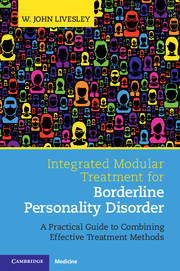 Integrated Modular Treatment for Borderline Personality Disorder
Integrated Modular Treatment for Borderline Personality Disorder Book contents
- Frontmatter
- Dedication
- Contents
- Preface
- Section 1 Introduction and Framework for Understanding Borderline Personality Disorder
- Section 2 Assessment and Treatment Planning
- 5 Diagnosis and Assessment
- 6 Formulation, Treatment Planning, and the Treatment Contract
- Section 3 General Treatment Modules
- Section 4 Safety, Containment, and Engagement: The Initial Phase of Treatment
- Section 5 Improving Emotional Regulation and Modulation
- Section 6 Exploration and Change: Treating Interpersonal Problems
- Section 7 Constructing an Adaptive Sense of Self
- Section 8 Retrospect and Prospect
- References
- Index
5 - Diagnosis and Assessment
from Section 2 - Assessment and Treatment Planning
Published online by Cambridge University Press: 16 February 2017
- Frontmatter
- Dedication
- Contents
- Preface
- Section 1 Introduction and Framework for Understanding Borderline Personality Disorder
- Section 2 Assessment and Treatment Planning
- 5 Diagnosis and Assessment
- 6 Formulation, Treatment Planning, and the Treatment Contract
- Section 3 General Treatment Modules
- Section 4 Safety, Containment, and Engagement: The Initial Phase of Treatment
- Section 5 Improving Emotional Regulation and Modulation
- Section 6 Exploration and Change: Treating Interpersonal Problems
- Section 7 Constructing an Adaptive Sense of Self
- Section 8 Retrospect and Prospect
- References
- Index
Summary
The goal of assessment is to establish a diagnosis and collect the information needed to construct a formulation to use in establishing the treatment contract and planning therapy. Integrated modular treatment (IMT) usually requires a slightly longer assessment than some therapies because the process is also used to engage the patient in treatment. This is important because many patients drop out either during assessment or before therapy starts. Dropout is reduced when clinicians also use the assessment interviews to build rapport and make a connection with the patient. This usually enhances the assessment because patients feel more involved and more open and communicative. The focus on engagement requires therapists to avoid being so focused on collecting information that they forget to monitor rapport. It also requires therapists to intervene promptly when rapport is poor or the patient is overly distressed, even if the assessment is to be put on hold until the problem is resolved.
Clinical Interview
Clinical assessment covers five major areas: (i) current symptoms, problems, and concerns; (ii) family history including details of parents, siblings, and family relationships; (iii) personal history including developmental history and current functioning; (iv) mental state; and (v) personality. Although most clinicians have a preferred way to cover these areas, a practical sequence is to follow the above order. Since the first four areas are part of a standard assessment, they will only be discussed briefly.
Current symptoms, problems, and concerns . Most assessments begin with an open-ended question about the reasons for seeking treatment. This provides information relatively quickly and engages the patient by focusing immediately on his or her current concerns. Open-ended questions also reveal the patient's capacity to organize thoughts, which is helpful in assessing the severity of his or her disorder. An immediate focus on current concerns also promotes the treatment alliance. Hence it is useful to work with the patient to compile a list of symptoms, problems, and concerns and explore the extent to which these difficulties have been present throughout the patient's life. The latter information helps to differentiate personality disorder from other mental disorders because personality disorders usually begin in adolescence or even earlier.
- Type
- Chapter
- Information
- Integrated Modular Treatment for Borderline Personality DisorderA Practical Guide to Combining Effective Treatment Methods, pp. 49 - 65Publisher: Cambridge University PressPrint publication year: 2017


